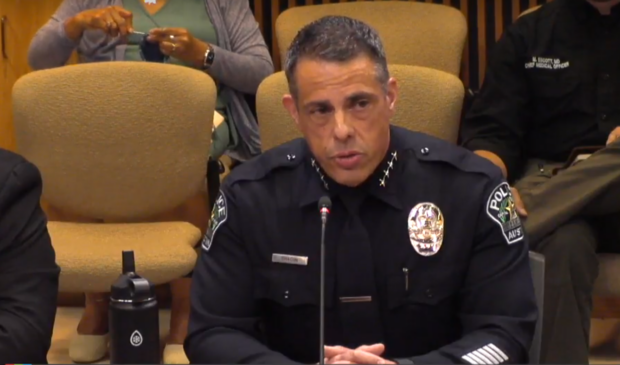Photo by ATXN. Police Chief Joseph Chacon announced his impending retirement last month.
Austin police chief turnover follows national trends
Friday, September 1, 2023 by
Emma Freer Austin Police Chief Joseph Chacon’s recent announcement that he will retire ushers in the city’s third search for a top cop in just over five years.
Experts say police chief turnover is an enduring challenge catalyzed in recent years by social change, including mass protests against police violence and racism in the summer of 2020 that prompted reform efforts in Austin and other cities across the country.
“Frequent turnover is not desirable,” Ben Brown, a professor of criminal justice at the University of Texas Rio Grande Valley who has studied police chief turnover in Texas, told the Austin Monitor. “If you have a new chief coming in every year or two, it just encourages instability across the department.”
In addition to potential instability, the Austin Police Department faces several other challenges, many of which predate Chacon’s appointment as chief. They include long-standing staffing shortages, stalled labor contract negotiations, backlash against its recent partnership with the Texas Department of Public Safety and internal resistance to reform.
Chacon’s permanent replacement has not been selected, but they will have their work cut out for them. But Laura Cooper, executive director of the Major Cities Chiefs Association, of which Austin is a member, said the talent pool is deep.
“There are qualified candidates that are out there,” she told the Monitor. “It really just comes down to the right fit.”
Short terms
Although data is hard to come by, police chief tenure is typically measured in years, not decades, given the demands and political nature of the job.
“It’s difficult to find what the average tenure is for a police chief,” said Mary Dodge, a professor of criminal justice at the University of Colorado Denver’s School of Public Affairs. “You see guesses – I’m going to call them educated guesses – (of) anywhere between two and six years.”
Cooper agreed, adding that turnover quickened in the wake of George Floyd’s May 2020 murder by a Minneapolis police officer. Since January 2020, the Major Cities Chiefs Association has recorded 75 turnovers among its 79 member agencies across the U.S. and Canada, some of which saw more than one chief depart. But there are signs this trend is slowing; Chacon’s retirement is only the second among its ranks so far this year.
Austin’s police leadership largely follows this pattern.
Chacon became chief in April 2021 and announced his retirement on Aug. 21, citing only “long conversations with (my) wife and family, and thoughtful prayer,” according to a statement.
Chacon’s predecessor, Brian Manley, was named interim chief in 2017 and then appointed to the permanent position in June 2018. He retired in March 2021, following a push to “reimagine public safety.” Before him, Art Acevedo held the position from 2007 to 2016, leaving for Houston after being reprimanded by city management for commenting on the police shooting death of an unarmed teen, as the Monitor previously reported.
Dodge emphasized that the job of a police chief is hugely demanding and often impacts the health and families of those who hold the position. These stressors are compounded, she said, by the obstacles chiefs face in implementing reforms, such as conflicting demands from various specialty groups, from city management and department employees to civilian oversight boards and elected officials.
“To make any kind of effective change takes probably a minimum of three to four years for a police chief,” she said. “Changes cannot just be made by leadership from top down.”
Contributing factors
Political upheaval and public division of public safety issues – both of which Austin has seen recently – also can drive chief turnover.
Five of Council’s 11 members, including Mayor Kirk Watson, were elected late last year. The new Council fired former City Manager Spencer Cronk in February, partly due his handling of the police labor contract negotiations. Interim City Manager Jesús Garza, who replaced Cronk, then announced the retirement of Rey Arellano, the assistant city manager who oversaw public safety, in March.
“The problem with police chiefs is they’re political appointees,” Brown said. “Often you get a new mayor or there’s a shakeup of the city council or you get a new city manager, somebody who may not get along with or agree with the chief of police on some issue.”
Similarly, Austinites have taken to the polls in response to fraught initiative petitions on public camping, reinstating a ban in May 2021; police staffing, rejecting a costly proposed minimum ratio of officers to residents in November 2021; and civilian oversight, expanding the Office of Police Oversight’s authority in May.
“If you have a lot of divisiveness among the citizens of a city, if the people are divided on the issues of … traffic, homelessness, whatever, that’s something that’s going to affect the job of the police chief,” Brown said.
Seeking a chief
Watson told KUT last week that the city will search for Chacon’s replacement, but he didn’t provide a time frame or a scale. In the meantime, Chief of Staff Robin Henderson will serve as interim chief of police – the same role both Chacon and Manley held before being appointed to the permanent position.
Both Dodge and Brown said there are advantages both to recruiting externally and promoting internally. External hires can be more effective change agents, and internal hires often provide a better culture fit.
Brown added that Austin might have an economic advantage over smaller or more beleaguered cities, given that its housing market is strong – and accordingly, so is the property tax revenue that funds municipal services.
Cooper also pointed to the local and state political environment as a factor, saying Austin could learn from cities such as Dallas and Houston “how to support a police department.”
But Brown argued there is little the city can do to mitigate chief turnover given the myriad factors at play.
“The best you can hope for is some sort of political stability within the city itself,” he said.
The Austin Monitor’s work is made possible by donations from the community. Though our reporting covers donors from time to time, we are careful to keep business and editorial efforts separate while maintaining transparency. A complete list of donors is available here, and our code of ethics is explained here.
You're a community leader
And we’re honored you look to us for serious, in-depth news. You know a strong community needs local and dedicated watchdog reporting. We’re here for you and that won’t change. Now will you take the powerful next step and support our nonprofit news organization?






